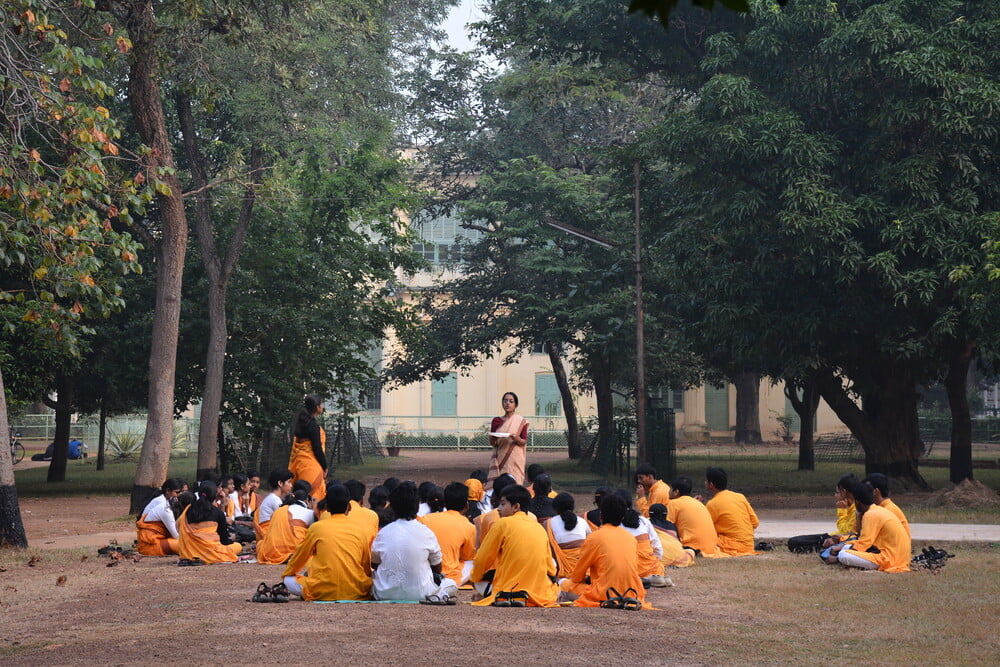Santiniketan is a special town in West Bengal. It is famous because a very important person, Rabindranath Tagore, started a unique university there over 100 years ago. Tagore won the Nobel Prize and is loved by many in India. Now, there is exciting news! Santiniketan has been added to the UNESCO World Heritage List.
Table of Contents
The Legacy of Rabindranath Tagore:
Nobel Laureate Rabindranath Tagore wasn’t just a poet; he was a visionary. When he established Santiniketan in 1901, he wasn’t setting up just another school; he was planting the seed for a cultural revolution. Here, amidst the serene settings, he introduced innovative teaching methods. Classes were often held under trees, breaking the walls of conventional classrooms. Tagore’s teachings always focused on holistic development, urging students to be in sync with nature and embracing arts as the soul’s language.
Art and Traditions at Santiniketan:
Santiniketan is synonymous with celebrating the uniqueness of traditional art forms. From the vibrant ‘Poush Mela’ showcasing Bengal’s folk music and dance to the beautiful handicrafts made by local artisans, it’s a hub of artistic excellence. Tagore’s emphasis on art education led to the creation of ‘Kala Bhavana’, an institute of fine arts within Santiniketan that to this day attracts students from all over the world.
Voices from the Heart:
Sarita, a local artisan, recalls, “I grew up hearing tales of Gurudev and his teachings. Santiniketan isn’t just a place; it’s an emotion, deeply rooted in our hearts.” A recent visitor, Raj, echoes similar sentiments, “The air here feels different; it’s as if every breeze whispers Tagore’s poetry.”
What is UNESCO and the World Heritage List?
UNESCO is a big organization that helps protect special places in the world. The World Heritage List is like a special club of these places. When a place joins this list, people from all over the world know it is very important.
How Did We Learn About This?
UNESCO shared this news on social media. They said, “New inscription on the @UNESCO #WorldHeritage List: Santiniketan, #India. Congratulations!” This was a proud moment for many people.

Why is Santiniketan Special?
In 1901, Tagore started Santiniketan. He called him Gurudev, which means a great teacher. He wanted to teach students in a different way. He wanted them to learn about art and the old Indian traditions. He also wanted people from different religions and cultures to be together in peace.
In 1921, Tagore made Santiniketan a ‘world university’. He named it Visva Bharati. This university was different from other places in India because of its buildings. While other places had British-style buildings, Santiniketan had buildings that looked like old Asian places.
What Do People Say About This News?
Many people are very happy about Santiniketan joining the UNESCO list. Prime Minister Modi said it is a proud moment for all Indians. He thinks this will make more people learn about Santiniketan and visit it.
The leader of West Bengal, Mamata Banerjee, also talked about this news. She said she is very happy and proud. She talked about how Tagore took care of Santiniketan and how people in Bengal love this place.

What Else Should You Know?
This isn’t the first place from Bengal to be on the UNESCO list. Bengal has other places too that are very special and important.
Santiniketan is not just a town or a university. It is a place where old traditions and new ideas come together. It is a place where people can learn, grow, and be together in peace. Now, with its place on the UNESCO list, more people will know about it and see its beauty. So, next time you think of special places in the world, remember Santiniketan in West Bengal, India.

